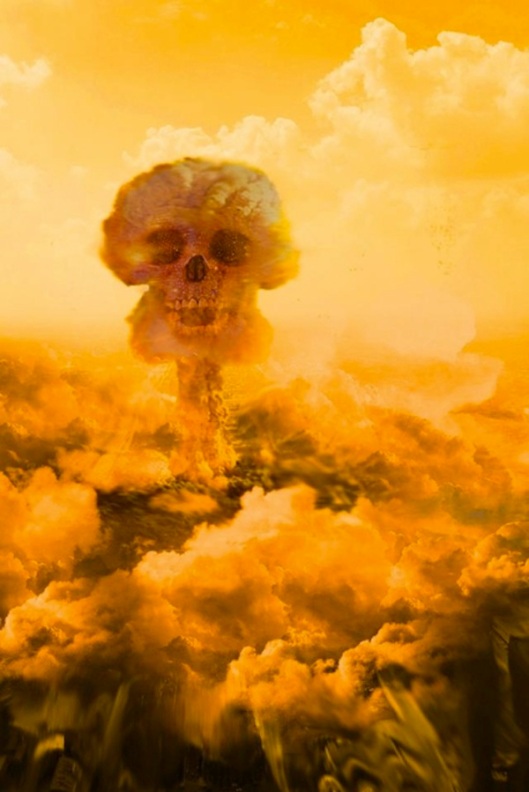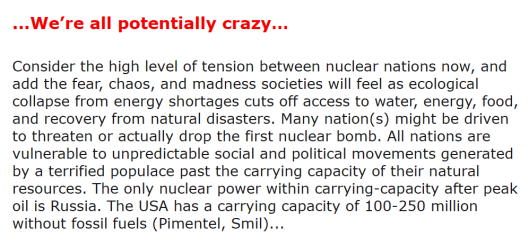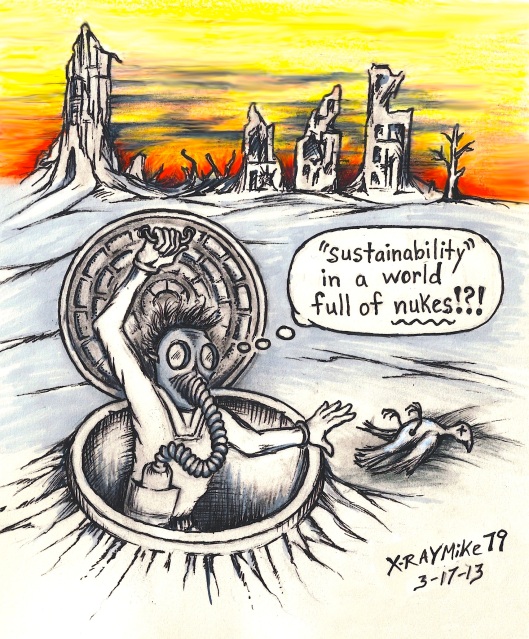Tags
Climate Change, Collapse of Industrial Civilization, Corporate State, Cyberwarfare, Eco-Apocalypse, Ecological Overshoot, Economic Collapse, Environmental Collapse, Hiroshima and Nagasaki, Inverted Totalitarianism, Iran, Iraq Invasion, Military Industrial Complex, Mutually Assured Destruction, North Korea, Nuclear Proliferation, Nuclear War, Operation Iraqi Freedom, Peak Oil, Resource Wars, Social Unrest, South Korea, Stuxnet Virus, The Nuclear Club, War for Profit, World War II
Ever since the dawn of the nuclear age, mankind has been living with the ever-present threat of mass annihilation. From the naive ‘duck and cover’ days of the Cold War to the present-day threat of a terrorist cell sneaking a nuke into a city on a truck, perhaps no single invention has affected the psyche of mankind. Nuclear weapons have only been used twice thus far, Hiroshima and Nagasaki. Contrary to the popular myth that the bombing of those two Japanese cities helped end the war, America used the already defeated Japan as a nuclear sacrificial lamb in order to intimidate Russia and limit Soviet expansion into Asia. So we have set the stage whereby any country, if it wants to gain respect and not face the threat of regime change, must strive to join the nuclear club. Nuclear proliferation cannot be stopped when nations see the power and status they can attain by becoming part of the club.
…For nuclear newcomers, the bomb is both a product of and an instrument for nationalist aspirations. Moreover, in this new, dangerously complicated world, nuclear weapons, while they may not be exploded, are assuredly used in many ways: to bluff, to intimidate, to rally the populace, to throw opponents off balance. “Anyone who says that nuclear weapons aren’t usable should take a look at North Korea,” Bracken writes. “Nuclear weapons are used every single day to extort food and oil from the rest of the world to keep the regime going.” Disarmament, he would say, is a sweet fantasy. The best we can hope for is to “manage” the nuclear menagerie — and we cannot be confident of success… –source
Below is a great interactive infographic showing who is in the nuclear club, who has nuclear plants as part of their energy mix, and who has both. As everyone should know, nations striving for nuclear energy also get on the fast track to obtaining nuclear bombs, if they so choose.
click on the image to use the infographic…
Lately, North Korea has once again been using its nukes as a political tool. The public opinion in South Korea has now fully swung toward the belief that they too must acquire the big stick of nukes in order to counter their neighbor’s threats.
…We, the Korean people, have been duped by North Korea for the last 20 to 30 years and it is now time for South Koreans to face the reality and do something that we need to do,” said Chung Mong-joon, a lawmaker in the governing Saenuri (New Frontier) Party and a former presidential conservative candiate. “The nuclear deterrence can be the only answer. We have to have nuclear capability…
…According to a February poll conducted by South Korea’s private think tank, Asan Institute, 66% of South Koreans said they support developing a nuclear weapons program. The poll suggests that just under half of South Koreans in 2012 believed that the United States would provide South Korea with what’s known as the “nuclear umbrella” in the case of a North Korean nuclear attack, indicating a 7% decrease from 2011…
Having 23 commercial reactors in operation makes South Korea one of the world’s top five commercial nuclear powers and gives it the ability to produce uranium or plutonium for nuclear weapons. South Korea could have nukes within 6 months.
We know that despite the setback Iran faced with the Stuxnet virus, it is only a matter of time before it develops nukes as well.
Now we get to the age of resource scarcity and climate destabilization, both of which have proven to be conflict multipliers. The grotesquely named Operation Iraqi Freedom was about nothing more than freeing up that country’s oil resources. Ten years later the country is in ruins, but Big Oil is benefitting (I’m surprised CNN ran this story):
…Oil was not the only goal of the Iraq War, but it was certainly the central one, as top U.S. military and political figures have attested to in the years following the invasion.
“Of course it’s about oil; we can’t really deny that,” said Gen. John Abizaid, former head of U.S. Central Command and Military Operations in Iraq, in 2007. Former Federal Reserve Chairman Alan Greenspan agreed, writing in his memoir, “I am saddened that it is politically inconvenient to acknowledge what everyone knows: the Iraq war is largely about oil.” Then-Sen. and now Defense Secretary Chuck Hagel said the same in 2007: “People say we’re not fighting for oil. Of course we are.”
For the first time in about 30 years, Western oil companies are exploring for and producing oil in Iraq from some of the world’s largest oil fields and reaping enormous profit. And while the U.S. has also maintained a fairly consistent level of Iraq oil imports since the invasion, the benefits are not finding their way through Iraq’s economy or society.
These outcomes were by design, the result of a decade of U.S. government and oil company pressure. In 1998, Kenneth Derr, then CEO of Chevron, said, “Iraq possesses huge reserves of oil and gas-reserves I’d love Chevron to have access to.” Today it does…
…Iraq’s oil production has increased by more than 40% in the past five years to 3 million barrels of oil a day (still below the 1979 high of 3.5 million set by Iraq’s state-owned companies), but a full 80% of this is being exported out of the country while Iraqis struggle to meet basic energy consumption needs. GDP per capita has increased significantly yet remains among the lowest in the world and well below some of Iraq’s other oil-rich neighbors. Basic services such as water and electricity remain luxuries, while 25% of the population lives in poverty…
…a leading coalition of Iraqi civil society groups and trade unions, including oil workers, declared on February 15 that international oil companies have “taken the place of foreign troops in compromising Iraqi sovereignty” and should “set a timetable for withdrawal.”…
In an age of mass delusion, inverted totalitarianism, and scapegoating, will the logic of MAD (mutually assured destruction) be enough to prevent a nuclear war? The energy skeptic sums up the failure of such thinking in the following quote:
And what of the odds even in a world not facing peak everything and climate chaos?
…The inevitability concept can best be understood by analogy to finance. It does not make sense to talk of an interest rate as being high or low, for example 50 percent or 1 percent, without comparing it to specific period of time. An interest rate of 50 percent per year is high. An interest rate of 50 percent per century is low. And the low interest rate of 1 percent per year builds up to a much larger interest rate, say 100 percent, when compounded over a sufficiently long time.
In the same way, it does not make sense to talk about the probability of nuclear war being high or low — for example 10 percent versus 1 percent — without comparing it to a specific period of time — for example, 10 percent per decade or 1 percent per year.
Having gotten the units right, we might argue whether the probability of nuclear war per year was high or low. But it would make no real difference. If the probability is 10 percent per year, then we expect the holocaust to come in about 10 years. If it is 1 percent per year, then we expect it in about 100 years.The lower probability per year changes the time frame until we expect civilization to be destroyed, but it does not change the inevitability of the ruin. In either scenario, nuclear war is 100 percent certain to occur….





http://nuclearrisk.wordpress.com/
http://www.nuclearrisk.org/
LikeLike
Horrific curse to the world…
3-20-2013
LikeLike
And one more thing… This world has gone completely fucking insane.
“Maybe they[Blair, Bush, Obama] should be locked up in a padded cell and given some real news to read.”
LikeLike
The inclusion of the Netherlands, Belgium, Germany, Italy and Turkey as having Nuclear Weapons is not accurate. They have no independent nation nuclear strike capability. However they may well have nuclear weapons stationed on their territory as members of the NATO Alliance. Those nukes would have been supplied by the US arm of the alliance.
Aside from the above, you’re doing a great job xraymike79. 🙂 It’s terrifying the depravity us humans can to descend to, re the depleted uranium contamination of Iraq.
LikeLike
Wiki has those countries listed as…
“NATO nuclear weapons sharing states (Belgium, Germany, Netherlands, Italy, Turkey)”
LikeLike
I don’t see how one can say that anything is 100% certain to occur. And the whole idea of putting odds of someting occurring seems a bit strange anyway. Who in 1930 would have considered the odds highly likely that in less than 10 years a psychpathic nut would take control of Germany and within 15 years attempt to conquer all of Europe, and come close to succeeding?
Sometimes things that “oddsmakers” consider quite likely to occur do not occur, and things they consider highly unlikely do occur.
LikeLike
A future nuclear war is not written in stone, but the significant factors which increase such a likelihood are that:
1.) Nations see the acquirement of nuclear weapons as a means to gain political leverage and power, especially those not kowtowing to the ‘Washington Consensus’. The historical track record is that regime change by western powers is less likely if one can obtain nukes.
2.) In an age of resource scarcity and climate disruption, both of which are conflict amplifiers, the chances of nuclear conflict will increase.
3.) Statistically speaking, nuclear proliferation increases the odds, and over a longer timespan, the odds are even greater.
4.) If you have a good grasp of how industrial civilization is undermining the planet’s biosphere, then the implications are even more terrifying.
LikeLike
Hey Mike – great post on yet another concern, in a long line of them now, addressing our diminishing prospects of any kind of “normal future” to which we once would have aspired. The fact that there is little cooperation among the gullible, distracted and manipulated masses to undo any of the on-going power grab by the elites, consolidating power and resources while decimating the chance for the rest of us (and indeed even most other species at this point) of a “good” life, practically assures cases like societal breakdown within countries (get them fighting against themselves for the crumbs that are left) and between countries who are in the way of their global plan.
It’s all winding down rather quickly – in fact the pace of change is accelerating as the environment degrades, we fail to change our ways (continue reliance on fossil fuels) and the signs of collapse (of all kinds) are plain and immanent.
Thanks for the great work you do.
LikeLike
@sandy
Nazi germany fought against the very psicopathic elite that is now destroying the planet, why do you think hitler has been so demonized?
LikeLike
I thought the Holocaust put Hitler in the club of butchers and ideologues.
LikeLike
So there`s still people who believe that fairy tale?
LikeLike
You are banned from this website, you screwball. Denying the Holocaust, talk of UFO’s, talk of the Illuminati, and other such nonsense will get anyone banned from here.
LikeLike
Thanks.
To prevent such nutjobs to deny it again: We (which means we germans) have the numbers and names of those we murdered.
You can not believe in fact. That’s why they are called facts.
To add something interessing to the discussion: Germany could probably build nuclear weaponry in a matter of months. Two years at most. That’s maybe a fact for most countries with nuclear powerplants, too.
LikeLike